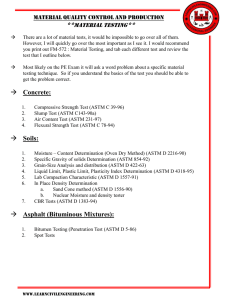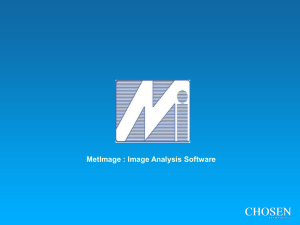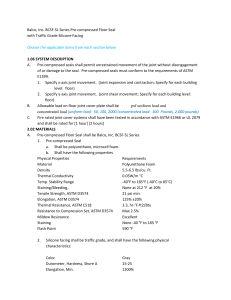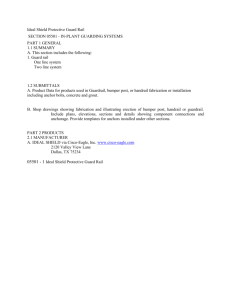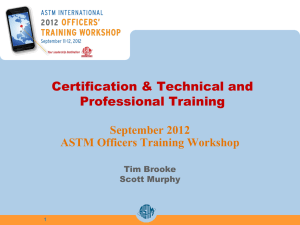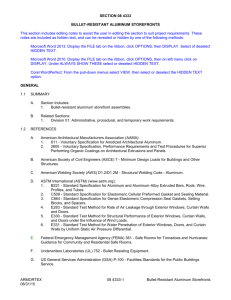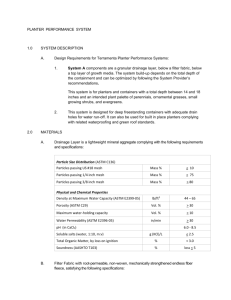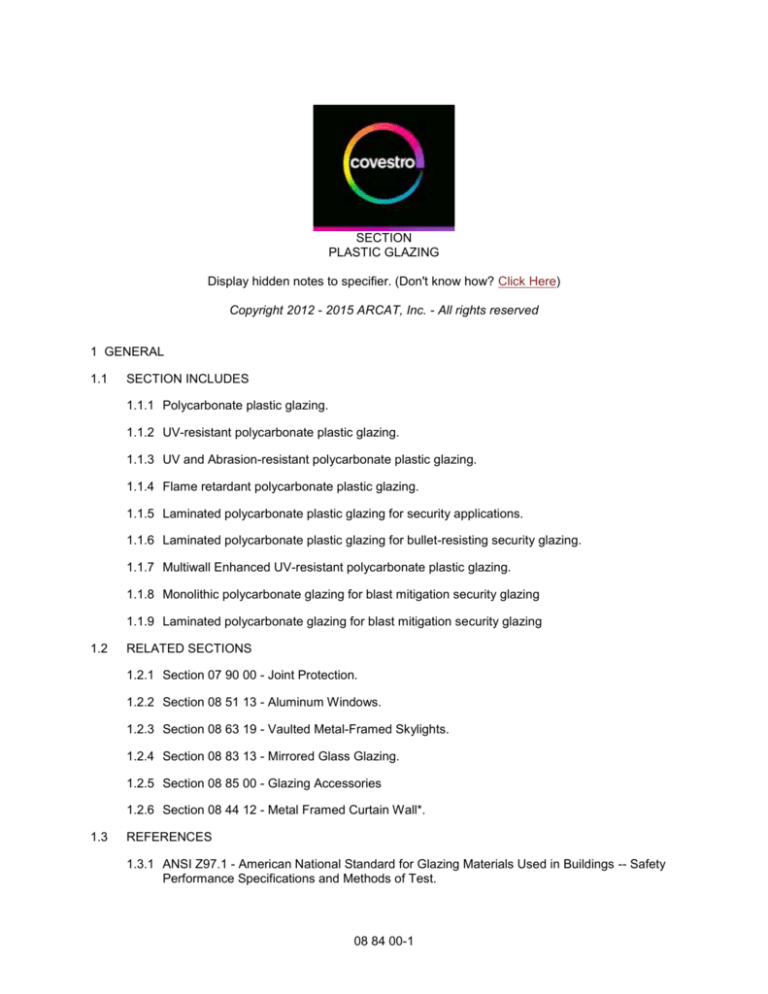
SECTION
PLASTIC GLAZING
Display hidden notes to specifier. (Don't know how? Click Here)
Copyright 2012 - 2015 ARCAT, Inc. - All rights reserved
1 GENERAL
1.1
SECTION INCLUDES
1.1.1 Polycarbonate plastic glazing.
1.1.2 UV-resistant polycarbonate plastic glazing.
1.1.3 UV and Abrasion-resistant polycarbonate plastic glazing.
1.1.4 Flame retardant polycarbonate plastic glazing.
1.1.5 Laminated polycarbonate plastic glazing for security applications.
1.1.6 Laminated polycarbonate plastic glazing for bullet-resisting security glazing.
1.1.7 Multiwall Enhanced UV-resistant polycarbonate plastic glazing.
1.1.8 Monolithic polycarbonate glazing for blast mitigation security glazing
1.1.9 Laminated polycarbonate glazing for blast mitigation security glazing
1.2
RELATED SECTIONS
1.2.1 Section 07 90 00 - Joint Protection.
1.2.2 Section 08 51 13 - Aluminum Windows.
1.2.3 Section 08 63 19 - Vaulted Metal-Framed Skylights.
1.2.4 Section 08 83 13 - Mirrored Glass Glazing.
1.2.5 Section 08 85 00 - Glazing Accessories
1.2.6 Section 08 44 12 - Metal Framed Curtain Wall*.
1.3
REFERENCES
1.3.1 ANSI Z97.1 - American National Standard for Glazing Materials Used in Buildings -- Safety
Performance Specifications and Methods of Test.
08 84 00-1
1.3.2 ASTM D 256 - Standard Test Method for Determining the Pendulum Impact Resistance of
Notched Specimens of Plastics.
1.3.3 ASTM D 412 - Standard Test Methods for Vulcanized Rubber and Thermoplastic
ElastomersTension.
1.3.4 ASTM D 624 - Standard Test Method for Tear Strength of Conventional Vulcanized Rubber
and Thermoplastic Elastomers.
1.3.5 ASTM D 635 - Standard Test Method for Rate of Burning and/or Extent and Time of Burning
of Plastics in a Horizontal Position.
1.3.6 ASTM D 638 - Standard Test Method for Tensile Properties of Plastics.
1.3.7 ASTM D 790 - Standard Test Methods for Flexural Properties of Unreinforced and
Reinforced Plastics and Electrical Insulating Materials.
1.3.8 ASTM D 792 - Standard Test Methods for Density and Specific Gravity (Relative Density) of
Plastics by Displacement.
1.3.9 ASTM D 1003 - Standard Test Method for Haze and Luminous Transmittance of
Transparent Plastics.
1.4
1.3.10
ASTM D 1048 - Standard Specification for Rubber Insulating Blankets.
1.3.11
ASTM D 1925 - Test Method for Yellowness Index of Plastics.
1.3.12
ASTM D 1929 - Standard Test Method for Ignition Properties of Plastics.
1.3.13
ASTM F 1233 - Standard Test Method for Security Glazing Materials and Systems.
1.3.14
ASTM F 1915 - Standard Test Method for Glazing for Detention Facilities.
1.3.15
UL 752 - Standard for Bullet-Resisting Equipment.
1.3.16
UL 792 - Standard for Bullet Resisting. Products.
SUBMITTALS
1.4.1 Submit under provisions of Section 01 30 00 - Administrative Requirements.
1.4.2 Product Data: Manufacturer's data sheets on each product to be used, including:
1.4.2.1
Physical properties including data on material weight, windload capacity, light
transmission, shading coefficient, and thermal expansion.
1.4.2.2
Preparation instructions and recommendations.
1.4.2.3
Storage and handling requirements and recommendations.
1.4.2.4
Installation methods and glazing procedures, including edge engagement
guidelines.
1.4.3 Selection Samples: For each finish product specified, two complete sets of color chips
representing manufacturer's full range of available colors and patterns.
1.4.4 Verification Samples: For each finish product specified, two samples, minimum size 6 inches
(150 mm) square, representing actual product and framed on two adjacent sides to show
glazing system.
1.4.5 Manufacturer's Certificates: Certify products meet or exceed specified requirements.
1.5
QUALITY ASSURANCE
08 84 00-2
1.5.1 Mock-Up: Provide a mock-up for evaluation of surface preparation techniques and
application workmanship.
1.5.1.1
Finish areas designated by Architect.
1.5.1.2
Do not proceed with remaining work until workmanship, color, and sheen are
approved by Architect.
1.5.1.3
Refinish mock-up area as required to produce acceptable work.
1.6
DELIVERY, STORAGE, AND HANDLING
1.6.1 Deliver polycarbonate sheets on enclosed pallets.
1.6.2 Store products in manufacturer's unopened packaging until ready for installation.
1.6.3 Store in dry, well ventilated and covered areas at temperatures below 80 degrees F (27
degrees C).
1.6.4 Handle polycarbonate sheets carefully to prevent damage; Do not drop, slide, or drag.
1.7
PROJECT CONDITIONS
1.7.1 Maintain environmental conditions (temperature, humidity, and ventilation) within limits
recommended by manufacturer for optimum results. Do not install products under
environmental conditions outside manufacturer's absolute limits.
1.8
WARRANTY
1.8.1 Provide manufacturer's written warranty covering breakage.
1.8.2 Provide manufacturer's written warranty covering breakage, loss of light transmission, and
yellowing.
1.8.3 Provide manufacturer's written warranty covering breakage, abrasion resistance, coating
failure, loss of light transmission, and yellowing.
1.8.4 Provide manufacturer's written 15 year warranty covering breakage, abrasion resistance,
coating failure, loss of light transmission, and yellowing.
2 PRODUCTS
2.1
MANUFACTURERS
2.1.1 Acceptable Manufacturer: Covestro LLC; Product Center Polycarbonate Sheets, which is
located at: 119 Salisbury Rd.; Sheffield, MA 01257; Toll Free Tel: 800-628-5084; Tel: 413229-8711; Fax: 413-229-8717; Email:request info (cindy.race@bayer.com);
Web:www.sheets.covestro.com
2.1.2 Substitutions: Not permitted.
2.1.3 Requests for substitutions will be considered in accordance with provisions of Section 01 60
00 - Product Requirements.
2.2
POLYCARBONATE SHEET GLAZING
2.2.1 Polycarbonate Sheet: Comply with ANSI Z97.1 and with properties as follows:
2.2.1.1
Specific gravity: 1.2 per ASTM D 792.
2.2.1.2
Tensile strength, yield: 9,000 psi (62 MPa), per ASTM D 638.
2.2.1.3
Tensile strength, ultimate: 9,500 psi (65 MPa), per ASTM D 638.
2.2.1.4
Tensile modulus: 340,000 psi (2344 MPa), per ASTM D 638.
08 84 00-3
2.2.1.5
2.2.1.6
2.2.1.7
2.2.1.8
2.2.1.9
Flexural strength at 5 percent strain: 13,500 psi (93 MPa), per ASTM D 790.
Flexural modulus: 345,000 psi (2378 MPa), per ASTM D 790.
Izod impact strength (0.125 inch (3.2 mm) notched): 16 ft lb/in (854 J/m) of
notch, per ASTM D 256.
Self ignition temperature: 1070 degrees F (577 degrees C), per ASTM D 1929.
Flash ignition temperature: 870 degrees F (466 degrees C), per ASTM D 1929.
2.2.2 General Purpose Type: Provide MAKROLON GP, UV stabilized plastic glazing sheet.
2.2.2.1
Thickness: 0.062 inch (1.5 mm) nominal.
2.2.2.2
Thickness: 0.080 inch (2 mm) nominal.
2.2.2.3
Thickness: 0.093 inch (2.4 mm) nominal.
2.2.2.4
Thickness: 0.118 inch (3 mm) nominal.
2.2.2.5
Thickness: 0.177 inch (4.5 mm) nominal.
2.2.2.6
Thickness: 0.220 inch (5.5 mm) nominal.
2.2.2.7
Thickness: 0.236 inch (6 mm) nominal.
2.2.2.8
Thickness:0.375 inch (9.6 mm) nominal.
2.2.2.9
Thickness: 0.500 inch (12.7 mm) nominal.
2.2.2.10 Finish Interior Side:Matte.
2.2.2.11 Finish Interior Side: Polished.
2.2.2.12 Finish Interior Side: Prismatic.
2.2.2.13 Finish Interior Side: Pebble.
2.2.2.14 Finish Interior Side: Textured.
2.2.2.15 Finish Exterior Side: Polished.
2.2.2.16 Finish Exterior Side: Polished.
2.2.2.17 Finish Exterior Side: Polished.
2.2.2.18 Finish Exterior Side: Polished.
2.2.2.19 Finish Exterior Side: Polished.
2.2.2.20 Color: Clear A00.
2.2.2.21 Color: Gray I30.
2.2.2.22 Color: Dark Gray I35.
2.2.2.23 Color: Green H35.
2.2.2.24 Color: White B54.
2.2.2.25 Color: Bronze K09.
2.2.2.26 Color: Custom color to match Architect's sample.
2.2.3 Enhanced UV Resistant Type: Provide MAKROLON UV plastic glazing sheet.
2.2.3.1
Thickness: 0.118 inch (3 mm) nominal.
2.2.3.2
Thickness: 0.177 inch (4.5 mm) nominal.
2.2.3.3
Thickness: 0.236 inch (6 mm) nominal.
2.2.3.4
Thickness: 0.375 inch (9.6 mm) nominal.
2.2.3.5
Thickness: 0.500 inch (12.7 mm) nominal.
2.2.3.6
Finish Interior Side: Polished.
2.2.3.7
Finish Exterior Side: Polished.
2.2.3.8
Color: Clear A00.
2.2.3.9
Color:Gray I30.
2.2.3.10 Color: Dark Gray I35.
2.2.3.11 Color: Green H35.
2.2.3.12 Color: Bronze K09.
2.2.3.13 Color: Custom color to match Architect's sample.
2.2.4 Abrasion Resistant and UV Enhanced Type: Provide MAKROLON AR hard-coated plastic
glazing sheet.
2.2.4.1
Thickness: 0.118 inch (3 mm) nominal.
2.2.4.2
Thickness: 0.177 inch (4.5 mm) nominal.
2.2.4.3
Thickness: 0.236 inch (6 mm) nominal.
2.2.4.4
Thickness: 0.375 inch (9.6 mm) nominal.
08 84 00-4
2.2.4.5
2.2.4.6
2.2.4.7
2.2.4.8
2.2.4.9
2.2.4.10
2.2.4.11
2.2.4.12
2.2.4.13
Thickness: 0.500 inch (12.7 mm) nominal.
Finish Interior Side: Polished.
Finish Exterior Side: Polished.
Color: Clear A00.
Color:Gray I30.
Color: Dark Gray I35.
Color: Green H35.
Color: Bronze K09.
Color: Custom color to match Architect's sample.
2.2.5 Abrasion Resistant and UV Enhanced Type: Provide MAKROLON 15 hard-coated plastic
glazing sheet.
2.2.5.1
Thickness: 0.236 inch (6 mm) nominal.
2.2.5.2
Thickness: 0.375 inch (9.6 mm) nominal.
2.2.5.3
Thickness: 0.500 inch (12.7 mm) nominal.
2.2.5.4
Finish Interior Side: Polished.
2.2.5.5
Finish Exterior Side: Polished.
2.2.5.6
Color: Clear A00.
2.2.5.7
Color:Gray I30.
2.2.5.8
Color: Dark Gray I35.
2.2.5.9
Color: Green H35.
2.2.5.10 Color: Bronze K09.
2.2.5.11 Color: Custom color to match Architect's sample.
2.2.6 Flame Retardant Plastic Glazing: Provide MAKROLON LF solid flame retardant
polycarbonate sheet. Meets requirements of UL 94 V-0 test criteria.
2.2.6.1
Thickness: 0.080 inch (2 mm) nominal.
2.2.6.2
Thickness: 0.093 inch (2.4 mm) nominal.
2.2.6.3
Thickness: 0.118 inch (3 mm) nominal.
2.2.6.4
Thickness: 0.177 inch (4.5 mm) nominal.
2.2.6.5
Thickness: 0.220 inch (5.5 mm) nominal.
2.2.6.6
Thickness: 0.236 inch (6 mm) nominal.
2.2.6.7
Finish Interior Side: Polished.
2.2.6.8
Finish Exterior Side: Polished.
2.2.6.9
Color: Clear A00.
2.2.6.10 Color:Gray I30.
2.2.6.11 Color: Bronze K09.
2.2.6.12 Color: Custom color to match Architect's sample.
2.3
LAMINATED POLYCARONATE SHEET GLAZING
2.3.1 Polycarbonate Laminated Sheet: Comply with ANSI Z97.1 and with properties as follows:
2.3.1.1
Specific gravity: 1.2, per ASTM D 792.
2.3.1.2
Tensile strength, yield: 9,000 psi (62 MPa), per ASTM D 638.
2.3.1.3
Tensile strength, ultimate: 9,500 psi (65 MPa), per ASTM D 638.
2.3.1.4
Tensile modulus: 340,000 psi (2343 MPa), per ASTM D 638.
2.3.1.5
Flexural strength at 5 percent strain: 13,500 psi (93 MPa), per ASTM D 790.
2.3.1.6
Flexural modulus: 345,000 psi (2378 MPa), per ASTM D 790.
2.3.1.7
Izod impact strength (0.125 inch (3.2 mm) notched): 16 ft lb/in (854 J/m) of
notch, per ASTM D 256.
2.3.1.8
Self ignition temperature: 1077 degrees F (581 degrees C), per ASTM D 1929.
2.3.1.9
Flash ignition temperature: 872 degrees F (467 degrees C), per ASTM D 1929.
2.3.2 Containment Glazing:
2.3.2.1
Two-ply Laminate Type: Provide HYGARD CG 375 two-ply polycarbonate
laminate with the following properties:
2.3.2.1.1 Overall Thickness: 0.39 inch (9.5 mm) plus/minus 5 percent tolerance.
08 84 00-5
2.3.2.1.2
Forced entry ratings: ASTM F1233 Class 2.8 BP/1.4 C; ASTM F 1915
Grade 3; H.P. White TP-0500 Level 1.
2.3.2.1.3 Ballistic Rating: H.P. White TP-0500.02 Level A (.38 Special).
2.3.2.1.4 Weight: 2.5 pounds per sq ft.
2.3.2.1.5 Shading coefficient: 0.92.
2.3.2.1.6 Light transmittance (clear): 86 percent.
2.3.2.1.7 Color:Clear A00.
2.3.2.1.8 Color:Gray I30.
2.3.2.1.9 Color: Dark Gray I35.
2.3.2.1.10 Color: Green H35.
2.3.2.1.11 Color: Bronze K09.
2.3.2.1.12 Color: Custom color to match Architect's sample.
2.3.2.2
Three-ply Laminate Type: Provide HYGARD CG 500 three-ply polycarbonate
laminate with the following properties:
2.3.2.2.1 Overall Thickness: 0.53 inches (12.7 mm). plus/minus 5 percent tolerance.
2.3.2.2.2 Forced entry ratings: ASTM F1233 Class II; ASTM F 1915 Grade 2; H.P.
White TP-0500 Level I.
2.3.2.2.3 Ballistic Rating: H.P. White TP-0500.02 Level A (.38 Special).
2.3.2.2.4 Weight: 3.3 pounds per sq ft.
2.3.2.2.5 Shading coefficient: 0.90.
2.3.2.2.6 Light transmittance (clear): 83 percent.
2.3.2.2.7 Color:Clear A00.
2.3.2.2.8 Color:Gray I30.
2.3.2.2.9 Color: Dark Gray I35.
2.3.2.2.10 Color: Green H35.
2.3.2.2.11 Color: Bronze K09.
2.3.2.2.12 Color: Custom color to match Architect's sample.
2.3.2.3
Three-ply Laminate Type: Provide HYGARD CG 750 three-ply polycarbonate
laminate with the following properties:
2.3.2.3.1 Overall Thickness: 0.78 inch (19 mm) plus/minus 5 percent tolerance.
2.3.2.3.2 Forced entry ratings: ASTM F1233 Class III; ASTM F 1915 Grade 1; H.P.
White TP-0500 Level II.
2.3.2.3.3 Ballistic Rating: H.P. White TP-0500.02 Level B (9 mm).
2.3.2.3.4 Weight: 4.9 pounds per sq ft.
2.3.2.3.5 Shading coefficient: 0.87.
2.3.2.3.6 Light transmittance (clear): 77 percent.
2.3.2.3.7 Color:Clear A00.
2.3.2.3.8 Color:Gray I30.
2.3.2.3.9 Color: Dark Gray I35.
2.3.2.3.10 Color: Green H35.
2.3.2.3.11 Color: Bronze K09.
2.3.2.3.12 Color: Custom color to match Architect's sample.
2.3.3 Bullet Resistant Glazing:
2.3.3.1
Three-ply Acrylic Interlayer Type: Provide HYGARD BR 750 three-ply
polycarbonate with acrylic interlayer with the following properties:
2.3.3.1.1 Overall Thickness: 0.78 inch (19 mm) plus/minus 5 percent tolerance.
2.3.3.1.2 Ballistics rating: UL 752 Level 1; H.P. White TP-0500 Level B.
2.3.3.1.3 Weight: 5.1 pounds per sq ft.
2.3.3.1.4 Shading coefficient: 0.89.
2.3.3.1.5 Light transmittance (clear): 88 percent.
2.3.3.1.6 Color: Clear A00.
2.3.3.1.7 Color:Gray I30.
2.3.3.1.8 Color: Dark Gray I35.
2.3.3.1.9 Color: Green H35.
2.3.3.1.10 Color: Bronze K09.
08 84 00-6
2.3.3.1.11 Color: Custom color to match Architect's sample.
2.3.3.2
Four-ply Laminate Type: Provide HYGARD BR 1000 four-ply polycarbonate
laminate with the following properties:
2.3.3.2.1 Overall Thickness: 1.05 inch (27 mm) plus/minus 5 percent tolerance.
2.3.3.2.2 Forced entry ratings: ASTM F1233 Class 5.0 BP/2.4C ; H.P. White TP0500 Level IV.
2.3.3.2.3 Ballistics rating: UL 752 Level 2.
2.3.3.2.4 Weight: 6.5 pounds per sq ft.
2.3.3.2.5 Shading coefficient: 0.93.
2.3.3.2.6 Light transmittance (clear): 72 percent.
2.3.3.2.7 Color: Clear A00.
2.3.3.2.8 Color: Gray I30.
2.3.3.2.9 Color: Dark Gray I35.
2.3.3.2.10 Color Green H35.
2.3.3.2.11 Color: Bronze K09.
2.3.3.2.12 Color: Custom color to match Architect's sample.
2.3.3.3
Four-ply Laminate Type: Provide HYGARD BR 1250 four-ply polycarbonate
laminate with the following properties:
2.3.3.3.1 Overall Thickness: 1.3 inch (33 mm) plus/minus 5 percent tolerance.
2.3.3.3.2 Forced entry ratings: ASTM F1233 Class 5.0 BP/2.5C ASTM F 1915
Grade 1; H.P. White TP-0500. Level IV.
2.3.3.3.3 Ballistics rating: UL 752 Level 3 . NIJ Level II, Level IIIA.
2.3.3.3.4 Weight: 8.1 pounds per sq ft.
2.3.3.3.5 Shading coefficient: 0.81.
2.3.3.3.6 Light transmittance (clear): 72 percent.
2.3.3.3.7 Color: Clear A00.
2.3.3.3.8 Color: Gray I30.
2.3.3.3.9 Color: Dark Gray I35.
2.3.3.3.10 Color: Green H35.
2.3.3.3.11 Color: Bronze K09.
2.3.3.3.12 Color: Custom color to match Architect's sample.
2.3.3.4
Four-ply Laminate Type: Provide HYGARD MS 1250 four-ply polycarbonate
laminate with the following properties:
2.3.3.4.1 Overall Thickness: 1.3 inch (33 mm) plus/minus 5 percent tolerance.
2.3.3.4.2 Ballistics rating: UL 752 Level 6; Supplementary Shotgun.
2.3.3.4.3 Weight: 8.1 pounds per sq ft.
2.3.3.4.4 Shading coefficient: 0.98.
2.3.3.4.5 Light transmittance (clear): 78 percent.
2.3.3.4.6 Color: Clear A00.
2.3.3.4.7 Color: Gray I30.
2.3.3.4.8 Color: Dark Gray I35.
2.3.3.4.9 Color: Green H35.
2.3.3.4.10 Color: Bronze K09.
2.3.3.4.11 Color: Custom color to match Architect's sample.
2.3.4 Blast Hazard Mitigation Laminate: Hygard EX 1100 blast hazard mitigation multi-ply laminate
with the following properties:
2.3.4.1
Abrasion Resistant Coating.
2.3.4.2
Overall Thickness: 1.06 inch (27mm) plus/minus 5 percent tolerance.
2.3.4.3
Weight: 6.5 lbs. / sf.
2.3.4.4
Code Approvals:
2.3.4.4.1 International Building Code (IBC) 2006 Edition.
2.3.4.4.2 ICC Evaluation Report.
2.3.4.4.3 Miami-Dade County, NOA.
2.3.4.5
High clarity, UV Enhanced Integral optical melt-bond interlayer:
2.3.4.5.1 Light Transmittance: 72 percent per ASTM D1003.
08 84 00-7
2.3.4.5.2 Haze: 0.5 percent ASTM D 1003.
2.3.4.6
Color:
2.3.4.6.1 Custom color matching approved sample.
2.3.4.6.2 Clear A00.
2.3.4.7
Visible Light Transmittance: 72 percent.
2.3.4.8
Shading Coefficient: .93
2.3.4.9
U Value: .60 BTU/ft2 h F.
2.3.4.10 Designated Pressure Blast: ___ (up to 42 psi / Positive Phase impulse ___ (up to
300psi-msec).
2.3.4.11 Blast Hazard Mitigation Rating: GSA TS01 Level D: Performance Condition 2;
UFC 4-010-01 / ASTM F 1642: No Hazard
2.3.4.12 AAMA 510-06: Complies
2.3.4.13 Ballistic Rating: UL 752 Level 2 point).
2.3.4.14 Forced Entry Rating: ASTM F1233 Class 5.0 BP/2.4C; H.P. White TP-0500.03
Level IV.
2.3.4.15 Containment Rating: ASTM F1915, Grade 1
2.3.5 Blast Hazard Mitigation Laminate: Hygard EX 1300 blast hazard mitigation multi-ply laminate
with the following properties:
2.3.5.1
Abrasion Resistant Coating.
2.3.5.2
Overall Thickness: 1.3 inches (33mm) plus/minus 5 percent tolerance.
2.3.5.3
Weight: 8.1 lbs. / sf
2.3.5.4
High clarity, UV Enhanced Integral optical melt-bond interlayer:
2.3.5.4.1 Light Transmittance: 78 percent per ASTM D1003.
2.3.5.4.2 Haze: 0.5 percent ASTM D 1003.
2.3.5.5
Color:
2.3.5.5.1 Custom color matching approved sample.
2.3.5.5.2 Clear A00.
2.3.5.6
Visible Light Transmittance: 78 percent.
2.3.5.7
Shading Coefficient: 0.98.
2.3.5.8
U Value: .56 BTU/ft2 h F.
2.3.5.9
Designated Pressure Blast ___ (up to 45 psi) / Positive Phase Impulse ___ (up
to 300 psi-msec).
2.3.5.10 Blast Hazard Mitigation Rating: GSA TS01 Level D: Performance Condition 2;
UFC 4-010-01 / ASTM F 1642: No Hazard.
2.3.5.11 AAMA 510-06: Complies.
2.3.5.12 Ballistic Rating: UL 752 Level 6, Supplementary Shotgun.
2.3.6 Blast Hazard Mitigation Laminate: Hygard EX 1275 multi-ply laminate with the following
properties:
2.3.6.1
Abrasion Resistant Coating.
2.3.6.2
Overall Thickness: 1.3 inches (33 mm) plus/minus 5 percent tolerance.
2.3.6.3
Weight 8.1 lbs. /sf.
2.3.6.4
High clarity, UV Enhanced Integral optical melt-bond interlayer:
2.3.6.4.1 Light Transmittance: 72 percent per ASTM D 1003.
2.3.6.4.2 Haze: 0.5 percent ASTM D 1003.
2.3.6.4.3 Yellowness index < 1.0 ASTM D 1925.
2.3.6.4.4 Tear Strength 240-280 pli ASTM D 624.
2.3.6.5
Color:
2.3.6.5.1 As selected from manufacturer's standard colors.
2.3.6.5.2 Custom color matching approved sample.
2.3.6.5.3 Clear A00.
2.3.6.6
Visible Light Transmittance: 72 percent.
2.3.6.7
Shading Coefficient: 0.81.
2.3.6.8
U Value: .51 BTU/ft2 h F.
2.3.6.9
Designated Pressure Blast ___ (up to 40 psi) / Positive Phase Impulse ___ (up
08 84 00-8
2.3.6.10
2.3.6.11
2.3.6.12
2.3.6.13
to 265 psi-msec).
Blast Hazard Mitigation Rating: GSA TS01 Level D: Performance Condition 2;
UFC 4-010-01 / ASTM F 1642: No Hazard
AAMA 510-06: Complies
Ballistic Rating: UL 752 Level 3; NIJ Level II, Level IIIA.
Forced Entry Rating: ASTM F 1233 Class 5.0 BP/2.5 C; ASTM F 1915 Grade 1;
HP White TP 0500 Level IV
2.3.7 Blast Hazard Mitigation System: Provide Hygard EX 250 blast hazard mitigation dual glazed
system with the following properties:
2.3.7.1
Abrasion Resistant Coating.
2.3.7.2
Code Approvals:
2.3.7.2.1 International Building Code (IBC) 2006 Edition
2.3.7.2.2 ICC Evaluation Report:
2.3.7.3
Flammability Rating: CC-1 / ASTM D 635
2.3.7.4
Safety Glazing Standards: CPSC: 16 CFR 1201, I, II / ANSI Z97.1
2.3.7.5
Burglar Resistant: UL 972
2.3.7.6
Color:
2.3.7.6.1 Custom color matching approved sample.
2.3.7.6.2 Clear A00.
2.3.7.7
Weight: 1.56 lbs. / sf
2.3.7.8
Light Transmittance: 84 percent.
2.3.7.9
Shading Coefficient: .97
2.3.7.10 U Factor 0.250 inch (summer gain, winter loss): 0.85 / 0.92 BTU/ft2 h F.
2.3.7.11 Designated Pressure Blast: 6 psi / Positive Pressure Impulse 42 psi-msec
2.3.7.12 Blast Hazard Mitigation Rating: GSA TS01: Performance Condition 2; UFC 4010-01 / ASTM F 1642 Hazard Level: No Hazard
2.3.7.13 AAMA 510-06: Complies
2.3.7.14 Typical EX250 Dual Glazed System:
2.3.7.14.1 Outer Lite:
2.3.7.14.1.1 Glass Type: Monolithic Glass
2.3.7.14.1.2 Glass Tint: Clear (For colors consult glass manufacturer)
2.3.7.14.1.3 Nominal Thickness: 6 mm
2.3.7.14.1.4 Glass Strength: ASTM C 1036 Type 1, Class 1 Quality-Q3
2.3.7.14.1.5 Coating Orientation: (N/A, Surface # 1 or 2)
2.3.7.14.2 Air Gap: 12 mm
2.3.7.14.3 Inner Lite:
2.3.7.14.3.1 Glazing Type: MAKROLON EX250
2.3.7.14.3.2 Nominal Thickness: 6mm
2.3.8 Blast Hazard Mitigation Monolithic Sheet: Provide Hygard EX 525 blast hazard mitigation
monolithic sheet with the following properties:
2.3.8.1
Abrasion Resistant Coating
2.3.8.2
Code Approvals: IBC
2.3.8.2.1 International Building Code (IBC).
2.3.8.2.2 ICC Evaluation Report.
2.3.8.3
Flammability Rating: CC-1 / ASTM D 635
2.3.8.4
Safety Glazing Standards: CPSC: 16 CFR 1201, I, II / ANSI Z97.1
2.3.8.5
Burglar Resistant: UL 972
2.3.8.6
Color:
2.3.8.6.1 Custom color matching approved sample.
2.3.8.6.2 Clear A00.
2.3.8.7
Weight: 3.12 lbs. /sf
2.3.8.8
Light Transmittance: 83 percent.
2.3.8.9
Shading Coefficient: .90
2.3.8.10 U Value: .74 BTU/ft2 h F.
08 84 00-9
2.3.8.11
2.3.8.12
Designated Pressure Blast: 6 psi / Positive Pressure Impulse 42 psi-msec
Blast Hazard Mitigation Rating: GSA TS01: Performance Condition 2; UFC 4010-0 / ASTM F 1642 Hazard Level: No Hazard
2.3.8.13 Forced Entry: ASTM F 1233 Class II; ASTM F 1915 Grade 2; H.P. White TP0500 Level 1.
2.3.8.14 AAMA 510-06: Complies.
2.3.8.15 Monolithic Lite:
2.3.8.15.1 Glazing Type: MAKROLON EX525
2.3.8.15.2 Nominal Thickness: 12 mm
2.3.9 Blast Hazard Mitigation System: Hygard EX 525 blast hazard mitigation dual glazed system
with the following properties:
2.3.9.1
Abrasion Resistant Coating .
2.3.9.2
Code Approvals:
2.3.9.2.1 International Building Code (IBC) 2006 Edition.
2.3.9.2.2 ICC Evaluation Report.
2.3.9.3
Flammability Rating: CC-1 / ASTM D 635
2.3.9.4
Safety Glazing Standards: CPSC: 16 CFR 1201, I, II / ANSI Z97.1
2.3.9.5
Burglar Resistant: UL 972.
2.3.9.6
Color:
2.3.9.6.1 Custom color matching approved sample.
2.3.9.6.2 Clear A00.
2.3.9.7
Weight: 3.12 lbs. /sf (weight of Makrolon EX525 only- glass weight not included)
2.3.9.8
Visible Light Transmittance: 83 percent.
2.3.9.9
Shading Coefficient: .90
2.3.9.10 U Value: .74 BTU/ft2 h F.
2.3.9.11 Designated Pressure Blast 10 psi / Positive Phase Impulse 89 psi-msec.
2.3.9.12 Blast Hazard Mitigation Rating: GSA-TS01 / Level D Blast Mitigation Resistance:
Performance Condition 2; UFC 4-010-0 / ASTM F 1642 Hazard Level: No
Hazard.
2.3.9.13 Forced Entry: ASTM F 1233 Class II; ASTM F 1915 Grade 2; H.P. White TP0500 Level 1.
2.3.9.14 AAMA 510-06: Complies.
2.3.9.15 Typical Makrolon EX525 Dual Glazed System:
2.3.9.15.1 Outer Lite:
2.3.9.15.1.1 Glass Type:Monolithic Glass.
2.3.9.15.1.2 Glass Tint: Clear (For colors consult glass manufacturer).
2.3.9.15.1.3 Nominal Thickness: 6 mm.
2.3.9.15.1.4 Glass Strength: ASTM D 1048 Type 1, Kind FT, Class 1 QualityQ3.
2.3.9.15.1.5 Coating Orientation: (N/A, Surface # 1 or 2).
2.3.9.15.2 Air Gap: 1 2mm.
2.3.9.15.3 Inner Lite:
2.3.9.15.3.1 Glazing Type: Makrolon EX525.
2.3.9.15.3.2 Nominal Thickness: 12 mm.
2.4
MULTI WALL POLYCARONATE SHEET GLAZING
2.4.1 Polycarbonate Sheet: Comply with ANSI Z 97.1 and with properties as follows:
2.4.1.1
Specific gravity: 1.2, per ASTM D 792.
2.4.1.2
Tensile strength, yield: 9,000 psi (62 MPa), per ASTM D 638.
2.4.1.3
Tensile strength, ultimate: 9,500 psi (65 MPa), per ASTM D 638.
2.4.1.4
Tensile modulus: 340,000 psi (2344 MPa), per ASTM D 638.
2.4.1.5
Flexural strength at 5 percent strain: 13,500 psi (93 MPa), per ASTM D 790.
2.4.1.6
Flexural modulus:345,000 psi (2378 MPa), per ASTM D 790.
2.4.1.7
Izod impact strength (0.125 inch (3.2 mm) notched): 16 ft lb/in/in (854 J/m) of
08 84 00-10
2.4.1.8
2.4.1.9
notch, per ASTM D 256.
Self ignition temperature:1070 degrees F (577 degrees C), per ASTM D 1929.
Flash ignition temperature: 870 degrees F (466 degrees C), per ASTM D 1929.
2.4.2 Multi Wall Glazing:
2.4.2.1
Multiwall Polycarbonate Sheet: Provide MAKROLON MULTI UV 2/4-6 multiwall
polycarbonate sheet with the following properties:
2.4.2.1.1 Overall Thickness: 4 mm.
2.4.2.1.2 Color/Light Transmittance:
2.4.2.1.2.1 Clear / 82 percent.
2.4.2.1.2.2 Opal / 51 percent.
2.4.2.1.2.3 Bronze / 48 percent.
2.4.2.1.2.4 White / 26 percent.
2.4.2.1.2.5 Blue / 45 percent.
2.4.2.1.2.6 Green / 49 percent.
2.4.2.1.3 Thermal Insulation: U-value 0.72 Btu/hr sf degrees F.
2.4.2.1.4 Coefficient of Thermal Expansion: 3.75 x 10-5 inch/inch/ degrees F.
2.4.2.1.5 Possible expansion due to heat and moisture: 0.003 inch/inch.
2.4.2.1.6 Maximum service temperature without load. 250 degrees F.
2.4.2.1.7 Coextruded UV protective layer on exterior face.
2.4.2.2
Multiwall Polycarbonate Sheet: Provide MAKROLON MULTI UV 2/6-6 t multiwall
polycarbonate sheet with the following properties:
2.4.2.2.1 Overall Thickness: 6 mm.
2.4.2.2.2 Color/Light Transmittance:
2.4.2.2.2.1 Clear / 80 percent.
2.4.2.2.2.2 Opal White / 45 percent.
2.4.2.2.2.3 Bronze / 45 percent.
2.4.2.2.2.4 White / 18 percent.
2.4.2.2.2.5 Blue / 43 percent.
2.4.2.2.2.6 Green / 49 percent.
2.4.2.2.3 Thermal Insulation: U-value/R-value 0.62/1.6 Btu/hr sf degrees F per
ASTM C 976.
2.4.2.2.4 Coefficient of Thermal Expansion: 3.75 x 10-5 inch/inch/ degrees F.
2.4.2.2.5 Possible expansion due to heat and moisture: 0.003 inch/inch.
2.4.2.2.6 Maximum service temperature without load. 250 degrees F.
2.4.2.2.7 Weighted sound reduction index: 10 db.
2.4.2.2.8 Coextruded UV protective layer on exterior face.
2.4.2.3
Multiwall Polycarbonate Sheet: Provide MAKROLON MULTI UV 2/8-10.5
multiwall polycarbonate sheet with the following properties:
2.4.2.3.1 Overall Thickness: 8 mm.
2.4.2.3.2 Color/Light Transmittance:
2.4.2.3.2.1 Clear / 80 percent.
2.4.2.3.2.2 Opal / 46 percent.
2.4.2.3.2.3 Bronze / 46 percent.
2.4.2.3.2.4 White / 14 percent.
2.4.2.3.2.5 Blue / 42 percent.
2.4.2.3.2.6 Green / 49 percent.
2.4.2.3.3 Thermal Insulation: U-value/R-value 0.60/1.7 Btu/hr sf degrees F, ASTM C
976.
2.4.2.3.4 Coefficient of Thermal Expansion: 3.75 x 10-5 inch/inch degrees F.
2.4.2.3.5 Possible expansion due to heat and moisture: 0.003 inch/inch.
2.4.2.3.6 Maximum service temperature without load. 250 degrees F.
2.4.2.3.7 Coextruded UV protective layer on exterior face.
2.4.2.4
Multiwall Polycarbonate Sheet: Provide MAKROLON MULTI UV 2/10-10.5 t
multiwall polycarbonate sheet with the following properties:
2.4.2.4.1 Overall Thickness: 10 mm.
08 84 00-11
2.4.2.4.2 Rib distance: 10.5 mm.
2.4.2.4.3 Color/Light Transmittance:
2.4.2.4.3.1 Clear 1099 / 80 percent.
2.4.2.4.3.2 White 1146 / 70 percent.
2.4.2.4.3.3 White 1140 IQ-Relax (Heat Reflecting) 70 percent.
2.4.2.4.3.4 White 1125 / 19 percent.
2.4.2.4.3.5 Blue 1545 / 42 percent.
2.4.2.4.3.6 Green 1650 / 54 percent.
2.4.2.4.3.7 Bronze 1850 / 56 percent.
2.4.2.4.3.8 Clear 4099 No drop.
2.4.2.4.4 Heat Transfer Coefficient: 3.1 w/m2 K per ASTM C 976.
2.4.2.4.5 Coefficient of Thermal Expansion: 0.065 mm/m degrees C..
2.4.2.4.6 Possible expansion due to heat and moisture: 3 mm/m.
2.4.2.4.7 Maximum service temperature without load. 120 degrees C.
2.4.2.4.8 Coextruded UV protective layer on exterior face.
2.4.2.5
Multiwall Polycarbonate Sheet: Provide MAKROLON MULTI UV 3X/16-25
multiwall polycarbonate sheet with the following properties:
2.4.2.5.1 Overall Thickness: 16 mm.
2.4.2.5.2 Structure: X-Structure.
2.4.2.5.3 Color/Light Transmittance:
2.4.2.5.3.1 Clear / 66 percent.
2.4.2.5.3.2 White / 54 percent.
2.4.2.5.3.3 Bronze / 26 percent.
2.4.2.5.4 Coefficient of Thermal Expansion: 3.75 x 10-5 inch/inch degrees F per
ASTM D 696.
2.4.2.5.5 Maximum service temperature without load. 250 degrees C.
2.4.2.5.6 Coextruded UV protective layer on exterior face.
2.4.2.6
Multiwall Polycarbonate Sheet: Provide MAKROLON MULTI UV 6/16-20
multiwall polycarbonate sheet with the following properties:
2.4.2.6.1 Overall Thickness: 16 mm.
2.4.2.6.2 Structure: 6 wall structure.
2.4.2.6.3 Color/Light Transmittance:
2.4.2.6.3.1 Clear / 59 percent.
2.4.2.6.3.2 White / 49 percent.
2.4.2.6.3.3 Bronze / 16 percent.
2.4.2.6.4 Coefficient of Thermal Expansion: 3.75 x 10-5 inch/inch degrees F per
ASTM D 696.
2.4.2.6.5 Maximum service temperature without load. 250 degrees C.
2.4.2.6.6 Coextruded UV protective layer on exterior face.
2.4.2.7
Multiwall Polycarbonate Sheet: Provide MAKROLON MULTI UV 5M/25-20
multiwall polycarbonate sheet with the following properties:
2.4.2.7.1 Overall Thickness: 25 mm.
2.4.2.7.2 Structure: 5-wall M-structure.
2.4.2.7.3 Color/Light Transmittance:
2.4.2.7.3.1 Clear / 49 percent.
2.4.2.7.3.2 White / 40 percent.
2.4.2.7.3.3 Bronze / 14 percent.
2.4.2.7.4 Coefficient of Thermal Expansion: 3.75 x 10-5 inch/inch degrees F per
ASTM D 696.
2.4.2.7.5 Maximum service temperature without load. 250 degrees C.
2.4.2.7.6 Coextruded UV protective layer on exterior face.
2.4.2.8
Multiwall Polycarbonate Sheet: Provide MAKROLON MULTI UV 5M/40-20
multiwall polycarbonate sheet with the following properties:
2.4.2.8.1 Overall Thickness: 40 mm.
2.4.2.8.2 R Structure: 5-wall M-structure.
2.4.2.8.3 Color/Light Transmittance:
08 84 00-12
2.4.2.8.3.1 Clear / 47 percent.
2.4.2.8.3.2 White / 35 percent.
2.4.2.8.3.3 Bronze / 10 percent.
2.4.2.8.4 Coefficient of Thermal Expansion: 3.75 x 10-5 inch/inch degrees F per
ASTM D 696.
2.4.2.8.5 Maximum service temperature without load. 250 degrees C.
2.4.2.8.6 Coextruded UV protective layer on exterior face.
2.5
ACCESSORlES
2.5.1 Glazing Accessories: As recommended by manufacturer of plastic glazing sheet for wet or
dry glazing installations
2.5.2 Glazing Accessories: In accordance with Section 08 85 00 - Glazing Accessories.
2.5.3 Sealants: In accordance with Section 07 90 00 - Joint Protection
3 EXECUTION
3.1
EXAMINATION
3.1.1 Do not begin installation until substrates have been properly prepared.
3.1.2 Inspect and verify that frame openings are correct size and conform to recommendations of
the plastic glazing sheet manufacturer.
3.1.3 If opening preparation is the responsibility of another installer, notify Architect of
unsatisfactory preparation before proceeding.
3.2
PREPARATION
3.2.1 Prepare surfaces using the methods recommended by the manufacturer for achieving the
best result for the substrate under the project conditions.
3.2.2 Clean frame contact surfaces with compatible solvent and wipe dry. Do not allow solvent to
pool in glazing channels.
3.2.3 Immediately prior to installation, expose glazing edges of plastic sheet by peeling back
factory-applied protective masking to a dimension sufficient for edge engagement.
3.3
INSTALLATION
3.3.1 Install plastic glazing in accordance with manufacturer's recommendations for edge
engagement and expansion allowance.
3.3.2 Sawing:
3.3.2.1
3.3.2.2
Cut using triple chip design saw blades at steady feed rate. Do not force material
through saw.
Sand or scrape cut edges smooth after sawing.
3.3.3 Mechanical Attachment:
3.3.3.1
Drill slightly oversized holes through plastic glazing and frames.
3.3.3.2
Install nuts, bolts and washers according to manufacturer's recommendations.
3.3.3.3
Use material backer strips with same strength and ballistic characteristics as
glazing material.
3.3.3.4
Ensure bolts are not overtightened.
3.3.4 Non-mechanical Installation:
08 84 00-13
3.3.4.1
3.3.4.2
Use wet or dry gaskets compatible with plastic glazing material.
Insert glazing tape between metal frame and plastic glazing and ensure there is
no contact between frame and glazing material.
3.3.5 Employ only sealants and glazing accessories that have been approved by manufacturer of
plastic glazing sheet.
3.3.6 Remove protective masking immediately after all glazing operations are completed.
3.4
PROTECTION
3.4.1 Protect installed products until completion of project.
3.4.2 Affix polyethylene film or other covering approved by plastic glazing sheet manufacturer to
framing members, as required to protect plastic glazing from other construction operations.
3.4.3 Repair or replace damaged products before Substantial Completion.
3.5
MAINTENANCE
3.5.1 Wash plastic glazing sheets regularly using soft cloth or sponge and mild soap and water
solution.
3.5.2 Dry using chamois or sponge.
3.5.3 Do not use abrasive cleaners or sharp instruments such as razor blades or scrapers that
may gouge plastic glazing sheet surfaces.
3.6
SCHEDULES
3.6.1 :
3.6.2 :
END OF SECTION
08 84 00-14

